Jason's website | home
1.6 and "95hp" NA tuning
This is my Miata Manila Dyno Runs Page.
Last updated 05Sep99, and Jan01.
The Miatae here, (except for one) have the Euro/Asian >1994 1.6, which is rated at 95hp, and uses the same cams as the US auto-tranny 1.6's, and revlimits at 6750 rpm instead of 7200. The cams have 10 degrees less duration (10 deg earlier closing on both exhaust and intake) We still have loads of fun with them. The Miata club of the Philippines is at "http://members.tripod.com/~ks98/home.htm .
Consistency of my version of Home Dyno.
3 consecutive runs of Jenny's car:
'91 US version Miata (1.6) mods: 14 deg timing, JR CAI, headers, catback, cat-ectomied.
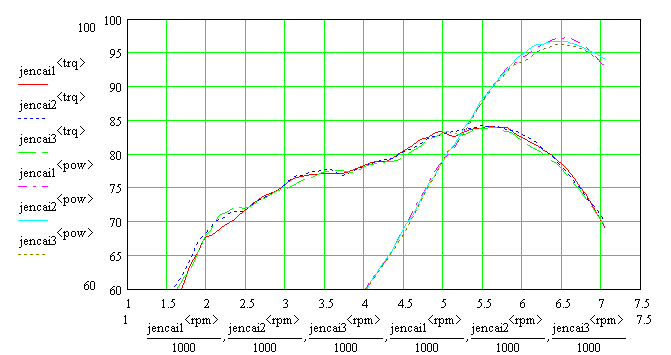
Dyno runs were done with software I wrote.
Note that all dyno plots on this page do not include does not include +7% correction for the temperature and humidity in Manila. These runs were done in 2nd gear, and Dynojet 4th gear runs would show an additional 8% because 2nd gear is more lossy.
I was surprised by how consistent the 3 consecutive runs were. The method and software are consistent.
US version '91 before and after full Jackson NA mods (CAI, exhaust)
Here is Jenny's car again, before and after the above mods (before, had 14 deg timing). Dyno readings taken on the same road.
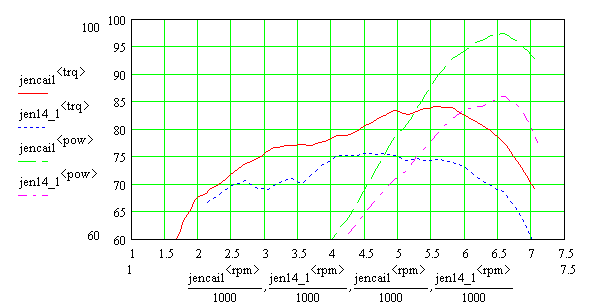
US '91 w/ JR stuff vs. 95hp engine w/ K&N cone
Here's Jenny's car against my car, which is a stock "95hp" 1.6, with K&N filter and 16 deg timing. Dyno readings taken on the same road.
Note how my torque drops above 4.5k rpm. The Euro/Asian >1994 1.6 is rated at 95hp, and uses the same cams as the US auto-tranny 1.6's. 15hp difference isn't too bad, considering I may gain 4hp from the muffler and 3hp from the CAI, closing the gap to 8hp.
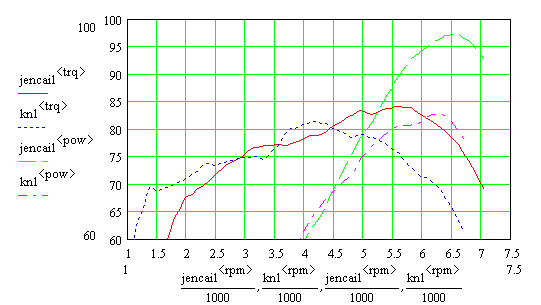
Timing
Here is the effect of timing, with the stock airbox but snorkel removed. 16 degrees was found to be best, not 14. At 18 deg, the midrange starts to drop. Effect is huge! Note that effect is least at around 3-4.5k rpm, indicating this is where the factory timing curve is most advanced wrt the optimum curve. This was taken on a different road from the above tests.
That's 6hp improvement, free! Apparently the Euro 1.6 engine responds differently (i.e. more) to timing changes.
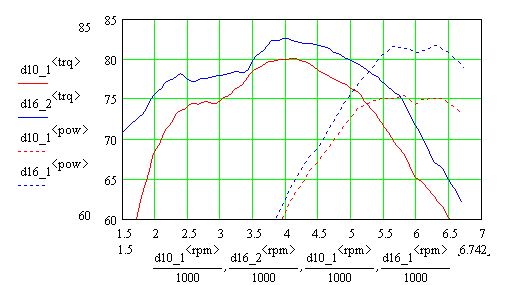
K&N cone filter
Here's the effect of the K&N filter, with 16 deg timing, against the stock airbox without the snorkel (2 runs shown). Torque curves:
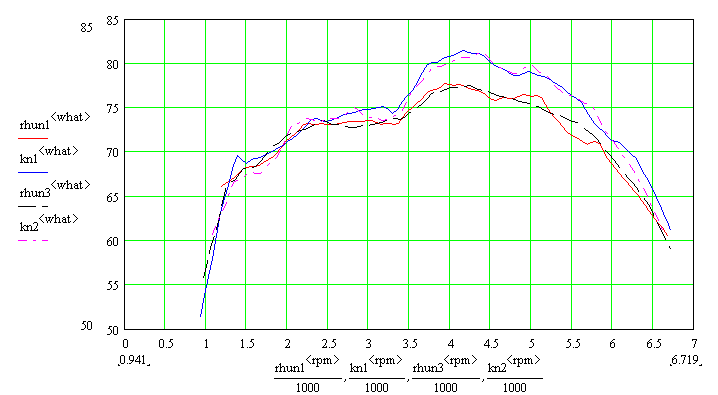
And power curves:
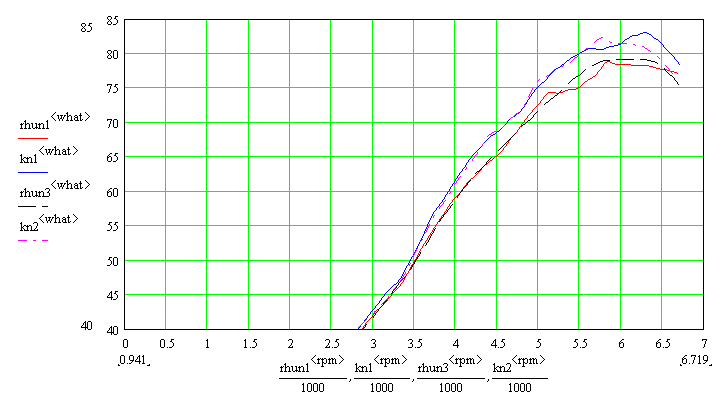
JR CAI only, before and after
Here are dyno runs showing the effect of a CAI. JoeyB's car;
Before: 14 deg timing, K&N cone, stock muffler
After: 14 deg timing, JR CAI, stock muffler
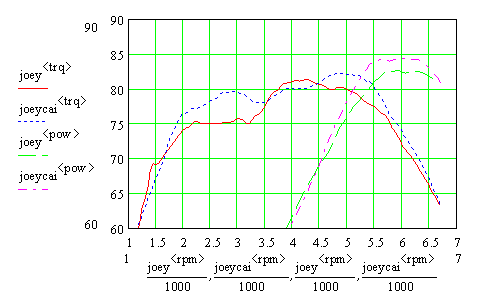
The surprise is the reshaping of the torque curve. It fills in the 2-3.5k region nicely, and adds quite a bit at 5k rpm. Seat of the pants clearly shows torque building up to 5k rpm instead of rolling off after 4k. I wonder what causes the loss of torque at 2.5k to 3k rpm.. the big resonator?
Next are some of the runs done in Subic last June.
95hp + Sebring, and water injection
The following are:
Keith: Sebring, exhaust, 6 deg timing
Streak: Sebring, water injection, 12 deg timing
Jenny: Above CAI'ed 1.6
Note: road where Jenny was dynoed is different from the other two so there may be a discrepancy.
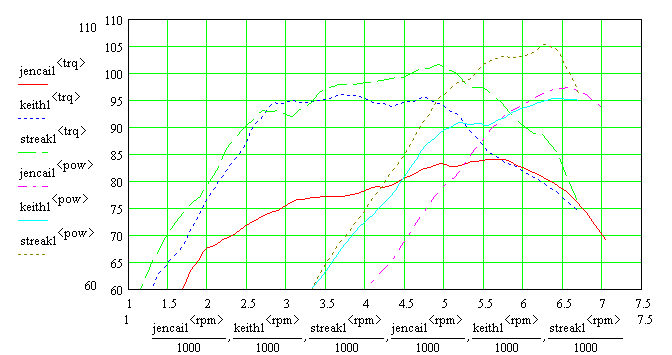
Water injection affords more timing, which makes a huge difference. Streak (Hernan's car) really feels more powerful. Jenny may have slightly more peak power than Keith, but Keith has more average power in the power band (4.5k-6.5k rpm), so overall Keith will win a drag race (given the same tire diameters) Keith happens to have huge tires (215x45x17) which will be a disadvantage in 1st gear and the launch. The Sebrings also have huge torque, starting at 2k rpm.
This begs the question: Why are the Sebrings only doing around 100 rwhp? See next plot.
Sebring vs. near stock 95hp
Here are the same 2 Sebringized Miatae, against Mig's engine, 95hp w/ unifilter and muffler.
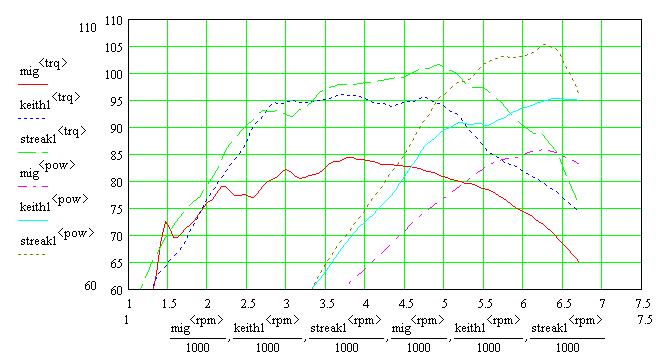
Here you can see that the Sebring gives around +30% torque from 2.5k up. This jives with calculations assuming 6psi non-intercooled. However nobody has yet connected a boost gauge to his Sebringized engine.
There is a theory that a positive displacement blower will force-feed an engine whatever air it ingests, which is a function of blower displacement and speed. If the engine is restrictive, boost pressure will rise to compensate.
The pulleys we have are the same as standard 1.6, so in theory power output should be the same as the Sebringized pre-1994 Miatae (120-140 rwhp). When we get boost gauge readings, we can see if the theory is correct. (Unless something else comes into play, like exhaust cam duration)
Muffler + filter
Here are 2 of the stockers in the club:
Miao: My car, 14 deg timing, stock airbox with no snorkel.
Mig: Miguel's car, 14 deg timing, freeflow muff, Unifilter (mounts like a cone filter).
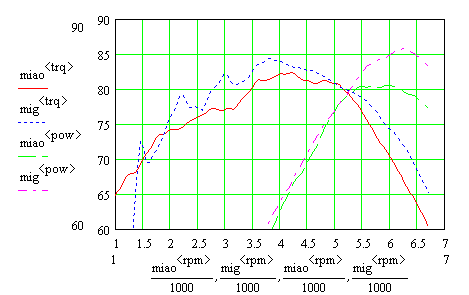
For some reason the data from Mig's car is "noisy" around 2.5k rpm. However, you can "visually smooth" the data.
With and without intake snorkel
Here is another stocker, "stocko" (Alfie's Miata), compared against Miao.
Stocko is bone stock, 14 deg timing:
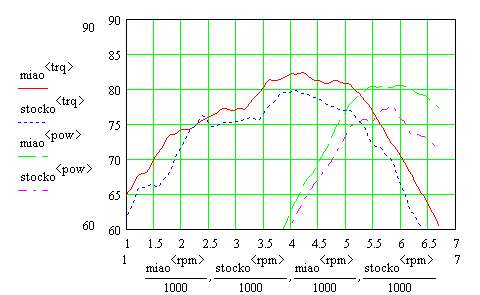
The difference between these 2 Miatae may be the intake snorkel. Since timing is worth about 6hp, the resulting ~72hp at the wheels jives with the 95hp rating.
In summary,
Timing 6hp
K&N cone 5hp
Muffler 4hp (?)
This is a total of 15hp, yielding ~105hp at the crank.
The mystery
The mystery of why our engines are rated 95hp whereas the U.S. auto tranny engines, with the same cams, are 105hp...
My guess is that the ECU is detuned at the top end - witness the 6 hp increase with a timing bump. The US Miatas hardly gain any topend with a timing bump.
Epilogue
I ended up putting a Greddy turbo on my "95hp" Miata. I examined the bottom end to make sure that the all-important oil spray is present. It was. The piston-cooling oil jets cools the pistons, and is one of the reasons that the Miata engine is quite turbo-friendly.